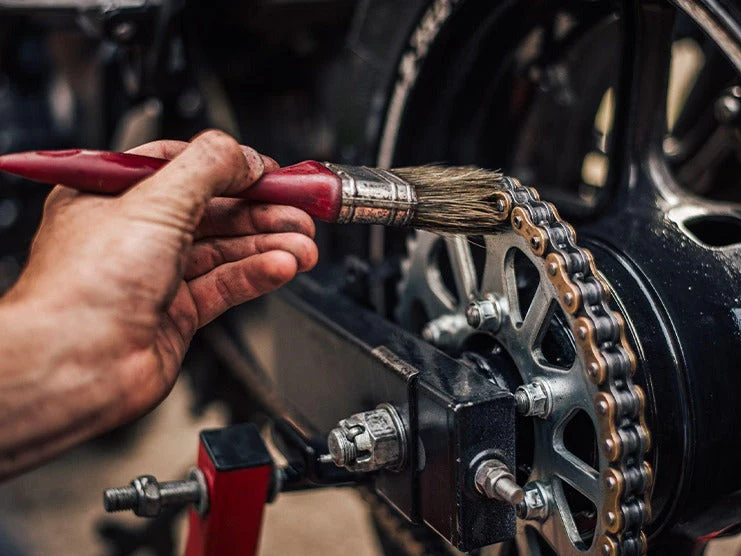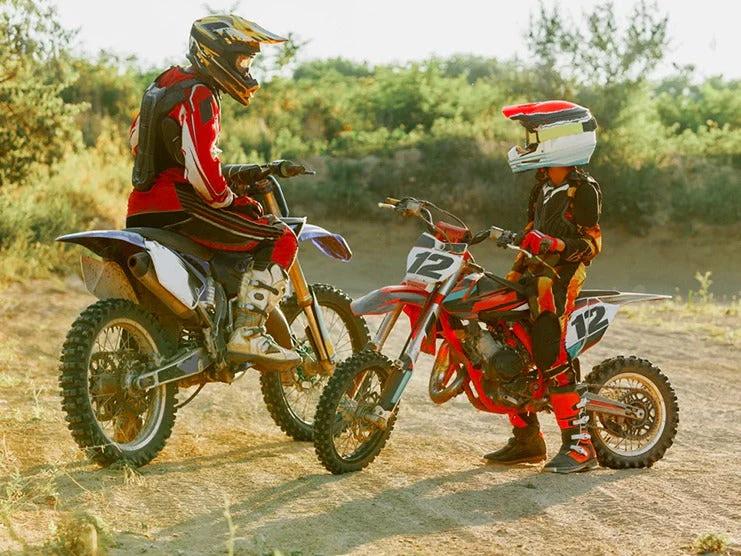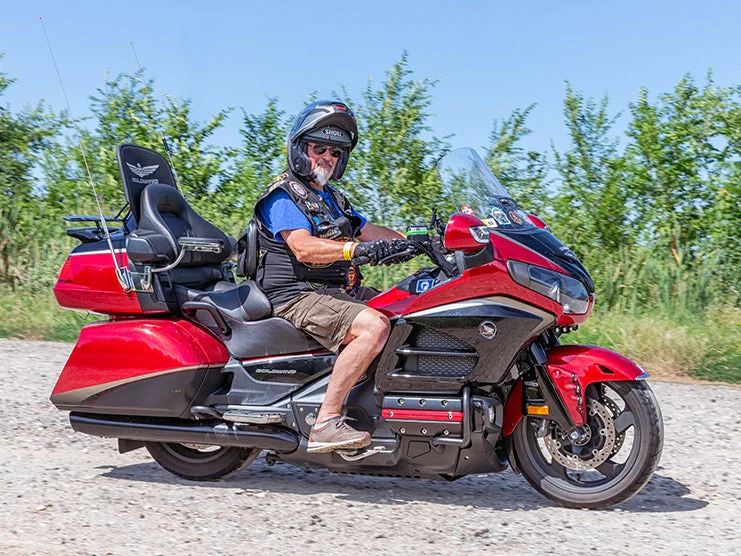Table of Content
Several mechanisms in motorcycles are responsible for ensuring a smooth power transfer from the engine to the rear wheel. One of the most widely used mechanisms is the chain sprocket. The chain sprocket connects the transmission to the rear wheel. The power produced by the engine is transferred to the transmission and then to the rear wheel via a chain sprocket. Since they are constantly moving throughout a ride, the chain and sprocket are constantly under stress and continuously grinding against each other when the motorcycle is accelerating, causing the chain sprocket to become worn down. Read this article to learn the top tips to increase chain sprocket life for any motorcycle.
1. What is a Chain Sprocket?

A chain and sprocket is a type of power transmission that drives the rear wheel. A sprocket is a round plate of metal with serrated teeth along the edges. Its teeth interlock with the chain to cause the rear wheel to rotate. The chain sprocket differs from gears as it does not mesh with other sprockets, and does not use a pulley with a smooth surface.
2. Top Tips to Increase Chain Sprocket Life for Any Motorcycle
2.1 Suitable Riding Condition
Depending on the type of motorcycle, it will be suited for specific purposes. For example, if you want a motorcycle capable of traveling at high speed, you should get a sports bike. If you want to go on long-distance rides and touring, a cruiser or touring bike is the right option. Similarly, if you love riding on dirt trails and going on adventure rides, dirt and adventure bikes are the best options.
To avoid damaging the sprocket and chain, make sure you only ride the motorcycle within the limits of its design. If your motorcycle is not capable of going off-road, avoid traveling over potholes, obstacles, and uneven roads that can damage the sprocket and chain. Tiny rocks and dirt particles get stuck to the chain and enter the sprocket teeth, making the chain and sprockets wear out more quickly.
2.2 Proper Alignment of the Front and Rear Sprockets

Most motorcycles have their front and rear sprockets connected by a chain. Both sprockets need to be aligned properly to ensure smooth chain movement against the sprockets’ teeth. However, if the sprockets are misaligned, the chain will move over the sprockets at odd angles, causing the chain to slip and the chain and sprockets to wear out faster.
2.3 Inspect and Service the Sprocket and Chain Frequently
If you ride a motorcycle regularly, you should check and maintain the chain sprockets frequently. This may also depend on the reason why you ride a motorcycle. If you are a professional motorcycle trainer or racer, you should maintain the chain sprocket every 2,000 miles. However, if you are a casual or weekend rider, you should inspect your sprockets every 3,000 miles. If you own a dirt bike and like going off-roading, the maintenance schedule will be more frequent.
Things to Check While Inspecting Chain and Sprocket
The following things must be checked while inspecting the chain and sprocket:
2.4 Lubrication

To increase the lifespan of a sprocket and chain, both must be properly lubricated. The motorcycle chain and sprockets constantly grind against each other as the rider twists the throttle. Due to the constant grinding, they gradually start to wear out. However, the friction between the chain and sprockets can be reduced by properly greasing them.
How to Clean and Lubricate the Motorcycle Chain Properly
Most older motorcycles had chain covers to prevent dirt from entering the chain and sprocket, helping them last longer. However, modern performance motorcycles do not have a chain cover, leaving their rear sprockets and chains exposed to dirt and dust. To prevent premature wear and tear, the chain and sprockets must be cleaned and inspected regularly to increase their lifespan.
If you need to lubricate the motorcycle chain properly to ensure smooth and better performance, follow the steps below:
- Park your motorcycle with the center stand down to have better access to the chain.
- Turn off the engine.
- Take a soft and clean cloth and hold the chain gently from the center (away from the sprocket).
- Slowly rotate the rear wheel by applying a little force. As the chain starts to move, it will remove dust from the chain.
- Lubricate the motorcycle chain by using a chain cleaner. There are several chain lubricants available in the market.
- As you apply the lubricant on the chain, slowly rotate the rear wheel until the whole chain is lubricated.
- Most motorcycle chain lubricants come in a spray bottle. Spray the lubricant on the chain while rotating the rear wheel to ensure the whole chain is covered.
2.5 Tension

To ensure better performance and acceleration, you must check the chain tension regularly. There must be a reasonable amount of slack in the chain to ensure operation. However, as the chain starts to become looser over time, it can reduce a motorcycle’s overall performance. While maintaining the chain, make sure the chain is not too tight to avoid slippage and wear and tear. A tight chain can damage the sprockets due to increased friction with the sprocket teeth.
Check the motorcycle owner’s manual for the required amount of slack in the chain and consult a professional mechanic to adjust the tension in the chain.
2.6 Condition
The condition of sprockets and chains can tell you so much about their age and the amount of wear and tear. If the gear shifting, power delivery, and acceleration are not smooth, it could be due to worn-out sprockets and chains. Rust may also start to build up if they are not replaced, maintained, and lubricated for a long time.
It is recommended you replace the sprockets and chain at the same time as a worn-out chain can quickly degrade the sprocket’s performance. By installing a new chain and sprockets, you will ensure a smoother riding experience.
3. When to Replace the Chain and Sprocket in a Motorcycle
The chain and sprockets must be replaced every 12,000-18,000 miles. The duration can vary depending on the riding conditions and frequency of use. You may need to replace the chain and sprockets early if you often go off-roading. However, if you find any damage to the chain or sprockets, you should replace them immediately.
4. Frequently Asked Questions (FAQs)
4.1 Which Oil is Best for Chain Sprocket?
The best chain sprocket oil/lubricant stays on the parts longer and produces less friction and smoother movement when the motorcycle chain runs around the sprockets. Different types of chain sprocket oils available on the market include dry, wet, paste, and wax. The best oil/lubricants for the chain sprocket include:
- Yamalube Synthetic Chain Lube
- PJ1 Black Label Heavy Duty Chain Lube
- Maxima Chain Wax
- Permatex Lube
- Bel-Ray Super Clean Lube
The oil/lubricants mentioned above last longer and are suitable for all motorcycles used in different riding conditions, including touring, cruising, and off-roading.
4.2 What Can Damage the Chain Sprocket?
There are several ways a motorcycle chain sprocket can become damaged. It could be due to a tight, loose, or misaligned chain. The chain sprocket can wear out quickly if the chain and sprockets are not lubricated properly, resulting in more friction and wear and tear. It is recommended you adjust the chain tension to the specifications provided in the motorcycle owner’s manual for better performance and acceleration.
4.3 What Causes Sprocket Failure?
If the chain and sprockets are not inspected regularly for any issues, they can eventually fail and stop operating smoothly. The sprockets can fail if they are not properly meshed with the chain. This can cause increased friction and generate more heat which could result in premature damage.
Poor sprocket alignment can also result in sprocket failure. As both, the chain and sprockets are linked to ensure smooth power delivery from the engine to the rear wheel, the chain must be in a good condition to avoid sprocket failure. The chain and sprocket failure during the ride can be life-threatening as it can seize the rear wheel movement.
4.4 What Sprocket is Best for Speed?
For high-speed performance, you will need a large front sprocket and a small rear sprocket to ensure taller gear ratios. Taller gear ratios allow more room to shift between gears. This transmission system is often installed on sports bikes.
4.5 What Sprocket is Best for Traveling Uphill?
If you love riding off-road dirt trails and traveling uphill, you need a motorcycle with a large rear sprocket and a small front sprocket. Such a power transmission mechanism is used in dirt bikes, touring bikes, and cruisers since they can produce more torque. A large rear sprocket with at least 28 or 32 teeth is best for riding uphill.
Also Read: 15 TIPS TO EXTEND YOUR MOTORCYCLE'S LIFESPAN
5. Takeaway
The chain and sprockets are integral parts of the power transmission system found on most motorcycles. If you have a worn-out chain and sprockets, you will experience poor acceleration, performance, and a bumpy riding experience. The chain and sprockets ensure smooth power delivery from the engine to the rear wheel. To make sure no engine power is lost while being transferred to the rear wheel, keep the chain and sprockets well-maintained, inspect them after every ride, clean and lubricate them properly, and adjust the chain slack when required. However, if there are visible signs of damage to the chain and sprockets during an inspection, it is best to replace the chain and sprocket to ensure better performance and acceleration.
Keeping a motorcycle well-maintained improves its performance and resale value. If you want to improve a motorcycle’s aesthetics, comfort, and safety, Viking Bags has several motorcycle parts available, including sissy bars, fairings, crash bars, handlebars, seats, and backrests. If you love motorcycle touring and want to improve storage capacity, you can install saddlebags, backpacks, tank bags, and handlebar bags.













Leave a comment
All comments are moderated before being published.
This site is protected by hCaptcha and the hCaptcha Privacy Policy and Terms of Service apply.